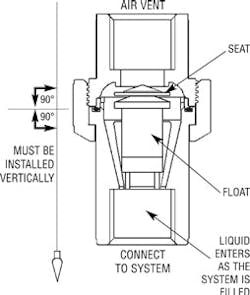How to Deal With the Dangers of Entrapped Air in Liquid Piping Systems
About the author:
Dave Patton is technical service advisor at Plast-O-Matic Valves. Patton can be reached at [email protected] or 973.256.3000.
One of the biggest issues that plagues liquid piping systems is the unwanted effects of entrapped air. This article discusses the different ways that air can enter a liquid system, the specific problems it can cause and how to safely remove it in a controlled fashion.
Means of Entry
There are three common ways that air can enter a liquid piping system.
The majority of air enters a system during the draining and filling of the lines. Any time liquid is removed from a piping system, air will fill the vacant space and pockets of air will remain in the line even after the system is refilled.
The second source of entry is harder to detect. Even though a closed system may seem like it is completely sealed, air can find its way through fittings, seals, pipe threads, O-rings and bearings. This typically happens where vacuum conditions occur, such as the suction side of a pump or at a venture-type eductor.
Surprisingly, the third mechanism for air entry is contained within the fluid itself. More than 2% of the total volume of standard municipal water is dissolved air. This is similar to the dissolved carbon dioxide found in carbonated beverages. Just like opening a can of soda, this dissolved air will come out of the solution when passing by low pressure zones, such as partially open valves, variations in flow velocity and changing pipe diameters. Once the air has left the solution, it rises to high points in the system and creates air pockets.
These air pockets can wreak havoc on the efficiency and safety of a piping system. As air bubbles collect at high points, they reduce the cross-sectional area that liquid can pass through. This essentially creates a choke point that increases head loss, reduces system efficiency and creates dangerous high-velocity currents.
In addition to increasing power consumption, these transient air pockets lead to a multitude of issues, ranging from erratic control valve operation to water hammer and pipeline corrosion, thereby damaging or destroying a piping system.
Overcoming Entrapped Air Issues
So how does one deal with these hidden dangers? Traditionally, someone climbed a ladder during system start-up and opened a vent valve on a riser, then quickly closed it as liquid rose in the system. This occasionally resulted in drenching the unlucky valve operator, sometimes with serious consequences.
Fortunately, technology has progressed to the point that there are three types of valves that can automatically release air from a piping system and prevent many, if not all, of the related hazards.
The simplest of these valves are air/vacuum valves, also known as air release valves. These valves feature an internal float that automatically drops open as fluid is draining and seals shut once the liquid level rises. This process allows the valve to expel large amounts of air as the system is filling during startup. In addition to startup venting, these valves also admit large amounts of air while the system is draining to protect against pipe-collapsing vacuum.
Air/vacuum valves should be placed at several locations throughout the system for the most efficient filling and draining. The first location is on the pump discharge. This allows for quick priming of deep well and vertical turbine pumps. Valves also should be placed along long piping ascents below the hydraulic grade line.
The air/vacuum valve is a solution to air-related issues during startup and shutdown, but what about the rest of the time? Since air constantly is being admitted into the piping system and outgassing from the media during normal operations, it needs to be dealt with on a continuous basis. Because the air/vacuum valve seals shut when a system is pressurized, a second type of release mechanism is needed. This is where an automatic degassing valve comes into play.
Automatic degassing valves also use an internal float, but have a much smaller venting orifice. As air bubbles collect inside the valve, water is displaced, the float drops and the air is seamlessly vented out of the system. This is particularly useful with sodium hypochlorite and other solutions prone to outgassing.
One area of concern in a water system is the accumulation of air within filter housings. As gas builds inside the housing it reduces flow rate and creates uneven filtration. This decreases throughput and increases filter wear. By installing degassing valves on top of filter housings this gas is continually vented, allowing the unit to work at full capacity. This reduces energy consumption, increases throughput and reduces filter costs.
The third option for eliminating air and gas is the “combination” air release and degassing valve, designed to reduce installation and maintenance costs. These combination valves contain the best of both worlds in one unit. They are best installed at high points in the system to provide air release during filling, continuous degassing during normal pressurized operations and vacuum protection while draining.
Through proper selection and placement of these air release, degassing and combination valves, operators can ensure efficient operation and alleviate many safety concerns in a liquid piping system.
Download: Here
